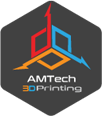FAQ
What is 3D Printing?
3D printing is a form of additive manufacturing technology where a three-dimensional object is created by laying down successive layers of material.
How does 3D printing work?
Although there are several things to keep in mind while 3D printing, the steps it takes to create a 3D print are pretty easy. Basically, this is the process for 3D printing:
- Download or design a 3D model
- Convert the 3D model to a 3D print file
- Start the 3D print
What is the use of a 3d printer?
Besides rapid prototyping, 3D printing is also used for rapid manufacturing. Rapid manufacturing is a new method of manufacturing where companies are using 3D printers for short run custom manufacturing. In this way of manufacturing the printed objects are not prototypes but the actual end user product.
What software can I use to create 3D models?
You are free to use any 3D modelling software for creating your 3D models. The only requirement is to be able to save or export the 3D model as a file format that is accepted by our software Cura. The file formats that are supported by Cura are: STL, OBJ, DAE and AMF.
Can I 3D print everything?
You can 3D print a lot of things, but as every technique has its limitations, not everything is possible. The most commonly used 3D printing technique is the Fused Filament Fabrication (FFF), with which layers of melted plastic are placed on top of each other. With this technique very complex structures or “overhanging” parts could be hard to print.
How long does it take to print something in 3D?
The time it takes to make a 3D print depends on the size of the model and the settings that you use for printing. A small object with low quality settings can already be printed in less than 10 minutes. But when you want to print a big object in high quality it could also take several hours. Factors that have a direct influence on the overall printing time are at your disposal. Like speed, resolution and the amount of infill.
Which materials can be used for 3D printing?
We usually recommend to use PLA (especially if you’re new into 3D printing), as this is the easiest material to print with due to its technical properties. For printing with a material like ABS a heated bed is recommended, since ABS has the tendency to warp when it cools down fast. However, there are other materials that can be used in 3D printing, such as wood or nylon, M-ABS or PET-G, glass bend or Flex 45, Carbon-P or MT bronze.
How fast is a 3d printer?
Currently, there are generally three sets of printing speed that 3D printers can support. The first set has been grouped at around 40 to 50mm/s, while the second set prints at about 80-100mm/s. Meanwhile, the fastest set prints at around150mm/s. Some printers may even print at a speed faster than 150 mm/s.s.
What is slicing in 3d printing?
There are two major types of software that will allow printing a (good read-to-print) 3D model file: A so-called slicer takes a 3D drawing (most often in STL format) and translates this model into individual layers. It then generates the machine code that the printer will use for printing.
What is minimal wall thickness and level of detail?
In 3D printing, wall thickness refers to the distance between one surface of your model and the opposite sheer surface. It’s defined as the minimum thickness your model should have at any time.
Level of detail can be described as the difference height between 2 surfaces.
Minimal wall thickness and level of detail both depend on the process being used.
What is the maximum possible height of a 3d printed model?
The maximum possible height of a 3d printed model depends on the height of the 3d printer. The maximum model height at AMTech is 66 cm.
